Friday, 4 August, Uglich, then on to Yaroslavl
Written 30 August 2017
When I described the cruise to a friend back before we came, he was surprised that it should take so long to cruise from Moscow to St. Petersburg. I assured him, on the basis of our 2015 Portuguese experience, that no, the ship would amble along, cruising for only a couple of hours a day, to give us more time in the ports of call for touring and sight-seeing.
Wrong. To get from Moscow down the Moscow canal and then up (in the sense of northward) the Volga to Uglich, our second stop, took almost 24 hours! So we were still cuising along the Volga when I got up at breakfast time. On the starboard side (the one I could see from my stateroom and my breakfast table, it was quite a ways across the water to the forested bank.
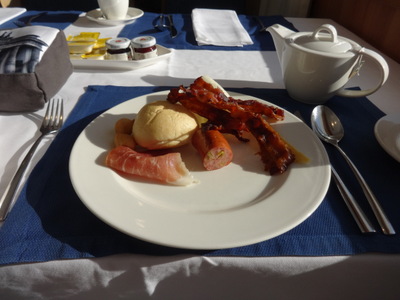
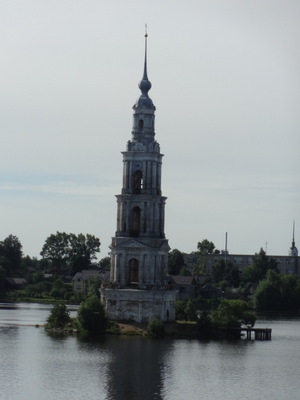 Here's my breakfast plate (while I wait for my eggs over easy from the omelet station) in the lovely low-angle light of the morning. The little green things in the sausage, which I took to be pistachios, turned out to be hot peppers. Nowhere near as good as the ones with cheese in them. The little bread buns, though, split and buttered and filled with raw ham make excellent French-style sandwiches.
Here's my breakfast plate (while I wait for my eggs over easy from the omelet station) in the lovely low-angle light of the morning. The little green things in the sausage, which I took to be pistachios, turned out to be hot peppers. Nowhere near as good as the ones with cheese in them. The little bread buns, though, split and buttered and filled with raw ham make excellent French-style sandwiches.
The unfortunate structure in the right-hand photo is simply the tallest tower, built on the highest hill, in a now-drowned village that was submerged when the Volga was dammed for the construction of locks, and only the first of several such vestiges we passed. Tour guides along the river gnash their teeth over the architectural treasures now under water.
Because we would be cruising all morning, and Viking is horrified by the idea that a guests might be bored, the time was filled with lectures. At 9 a.m., I showed up in the Sky Bar for a lecture on the Romanov Dynasty by tour escort Vadim. (Because even the Sky Bar wouldn't hold everyone, he gave the it twice, and everyone was asked to show up at the first if they were in the previous days groups 3A, B, C and at the second if they were in groups 3D, E, F; the Akun is boat #3 of Viking's Russian fleet of four, so all our group numbers start with 3; you wouldn't want to get confused in Red Square and follow a guide carrying a lollipop from a different Viking ship!)
It was really interesting. I hadn't brought a legal pad on the trip, so I brought along some of the Viking literature to take notes on the back, but I would up filling my two blank sheets and taking the rest of my notes in the margins of the announcements on the front.
Russia's original dynasty, the one in power since Russia coalesced into a national, was the Ruriks. It ended with the death of Ivan IV (the Terrible) in 1584. He accidentially killed his older son (well, he was really mad and hit him on purpose, but he apparently didn't mean to kill him), and his younger son, 9-year-old Dmitri (the one who was epileptic and supposedly had a seizure while playing with a knife and cut his own throat), is the one who was probably murdered by Boris Gudonov. So after Ivan IV died, there was no clear heir, and the time that followed was called the Time of Troubles. Boris Gudonov ruled for a while, two successive pretenders arose (the "False Dmitris") claiming to be little Dmitri, who had survived after all, but they were both repulsed.
Finally the Boyars (the nobles) got together and (as was actually provided for in Russian law) elected an official success in 1613. That was the young Michael Romanov (a nephew of Ivan IV), founder of the Romanov dynasty that ruled until the revolution in the early 20th century.
Michael was only 17 at the time and was a pious and diffident sort of person, so his father, grandfather, and other relatives did much of the ruling. He left four children to survived to adulthood and was succeeded by his oldest son, Alexei I. During his 30-year reign, Russian explorers reached the Pacific ocean. He had 13 children by his first wife and 1 boy by his second.
The third Romanov tsar was Feodor III, eldest surviving son of Alexei I. He was smart, well educated, and had a "nobel nature," but he was disabled by a childhood disease. He was nevertheless an energetic reformer. His first wife and baby died, and he died so soon after his second marriage that he left no issue.
He was succeeded by two half brothers who ruled jointly: Ivan V (youngest son of Alexei I by his first wife) and Peter I (only son of Alexei I by his second wife). Ivan was 1 at the time, and Peter was 10. They were crowned jointly because Ivan was sickly and feebleminded and wasn't expected to live long. He nonetheless married and produced five daughters, three of whom lived to adulthood.
When Ivan V died in 1696, Peter I took over and grew up to be Peter the Great. You'll hear a lot about him in this blog, but he died in 1725, leaving no will and legitimate heir. He had had a son, Alexei, by his first wife, but Peter suspected him of plotting against him and had him imprisoned and tortured. The son died in prison, but he in turn left a son.
He was succeeded by his second wife, Catherine I, who ruled for about two years.
She was succeeded by Peter II, the grandson of Peter I (the son of the one who died in prison). His mother died young, and none of his relatives, least of all his grandfather, liked him, so the young Peter was kept in seclusion and only gained some education later in life when it was clear that he should probably inherit the throne. He ruled for about three years.
Peter II was succeeded by Anna Ivanovna, one of the daughters of Ivan V. She had married the Duke of Courland in 1710 and was ruling there as regent in 1730, when she became Empress of Russia. She ruled for 10 years.
Next in line was Elizaveta Petrovna, daughter of Peter I and Catherine I, who ruled for about 20 years.
After her came Peter III, son of Anna Petrovna, another of the daughters of Peter I and Catherine I. He was born and brought up in Holstein-Gottorp, where his mother had married the duke. He was a crummy emperor, but fortunately (I guess) had married a strong-minded young woman named Catherine (a German princess from Anhalt-Zerbst, where she was named Sophie until she took the name Catherine when she converted to Russian orthodoxy to marry Peter). She deposed him six months into his reign, took over the job herself and grew up to be Catherine the Great. She reigned for 34 years. Peter died mysteriously shortly after the coup.
Catherine was succeeded by her son Paul I, whose biological father probably wasn't Catherine's husband, Peter III. Paul ruled for about 5 years. He was paranoid about assassination conspiracies, so he built the only "castle" (in the sense of fortified residence) in Russia, where he was assassinated in his own bed about two weeks after moving in.
He was succeeded by his 23-year-old son Alexander I, who ruled for about 24 years and left no heir. After a time of argument between Alexander's two brothers, neither of whom wanted the job, he was succeeded by his younger brother Nicholas I (who was also the King of Poland and the Grand Duke of Finland).
Nicholas I was succeeded by his son Alexander II, who reinstated a lot of the reforms that his two predecessors had reversed. He also liberated the serfs and introduced many other reforms. He also sold Alaska to the U.S. (afraid it would fall into British hands if another war arose). He ruled for about 35 years, until he was assassinated.
He was succeeded by his son, Alexander III, "the peacemaker." Like his father than grandfather, he was also King of Poland and Grand Duke of Finland. He's the one who built the Cathedral on the Spilled Blood in St. Petersburg, on the spot where his father was dismembered by a nihilist's bomb thrown into his carriage. He's also the namesake of my favorite bridge in Paris! He ruled for about 13 years.
His successor was the 17th and last tsar of the Romanov dynasty. Nicholas II. He and his family were assassinated during the revolution in 1918. The remains have been found, mingled with those of some others who were killed with them, and DNA testing is ongoing to sort out who's who. Positive identification of one daughter and the son are still pending, but Anastasia has been positively identified among the bones, so pretenders to that identity can give it a rest.
Getting this succession sorted out in my mind made helped a lot with the all the subsequent history we were told. Here's the summary:
- Michael I
- Alexei I
- Feodor III
- Ivan V
- Peter I (the Great)
- Catherine I
- Peter II
- Anna Ivanovna
- Elizaveta I
- Peter III
- Catherine II (the Great)
- Paul I
- Alexander I
- Nicholas I
- Alexander II
- Alexander III
- Nicholas II
Then, as if my head weren't already buzzing with new information, our first Russian language lesson, by tour escort Alexei, was scheduled for 11:15 a.m.! No shifts for that one—apparently they expected a lower turnout.
Alexei have us a handout showing the Russian alphabet, with its Roman alphabet equivalents. On its flip side were common useful phrases in Russian, both in Cyrillic and in transliteration.
Not all the letters of the Russian alphabet have Roman equivalents. One he just listed as "no equivalent," so I have no idea what it is or does (it might be a vowel). Two others have no sounds of their own but make the sound they follow "hard" or "soft" (not hard or soft as we use it with respect to "c" or "g," and not voiced or voiceless). He repeatedly pronounced the difference, but I couldn't hear it, and I never got the chance to ask him to describe the difference in phonetic terms.
I skipped the second language lesson, a few days later, so the only phrases I really mastered were "thank you" (pronounced "spa-SEE-buh"), good morning (pronounced, more or less, "dobray ootra," with a rolled "r"), and good afternoon (pronounced, more or less, "dobry dyayn"). Their use is complicated by the definitions of morning and afternoon, which differ from ours. You can only say "good morning" until about 11 a.m.; then you can say "good afternoon" until dusk (which is, say 3 p.m. in late December and 10 p.m. in midsummer). I think there's even a limit on how early you can say "good morning"; before that it's still "good night" even if the sun's up.
He also taught us an all-purpose "hello"—pronounced, he claims, "zdrastvooite"—that you can say to anyone, anytime. The minute you use any other greeting, you find yourself knee-deep in case endings depending on gender and relationship with the addressee. Russian uses six different cases (more than Latin!). An example he pointed out was the inscription on a monument dedicated to Pushkin. It gave Pushkin's first name, patronymic, and last name, each with "y" (pronounced "oo") on the end. That means "to Pushkin," even though no word meaning "to" is included in the inscription. I have mixed feelings about case grammar—very economical but a bear for foreigners to learn.

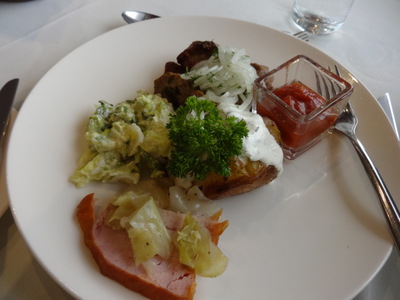 Lunch started with the usual buffet. The featured items were Ukrainian tomatoes —tomato halves with machicolated edges stuffed with cheese, garlic, and sour cream—which I didn't try, and pork loin with braised cabbage.
Lunch started with the usual buffet. The featured items were Ukrainian tomatoes —tomato halves with machicolated edges stuffed with cheese, garlic, and sour cream—which I didn't try, and pork loin with braised cabbage.
The left-hand photo shows an assortment of marinated vegetables and some salad from the buffet, plus a little salmon-and-egg canape. The one at the right shows the Russian entrée specialty—"shashlik" (Caucasus-style grilled meat skewers; the skewers were removed in the kitchen) with baked potato, savoy cabbage, and shashlik sauce. At 7 o'clock on the plate is the pork loin (actually pork loin ham) with braised cabbage). I don't think anyone ordered the cream of tomato soup, the BLT with slaw and fries, or the fusilli primavera.
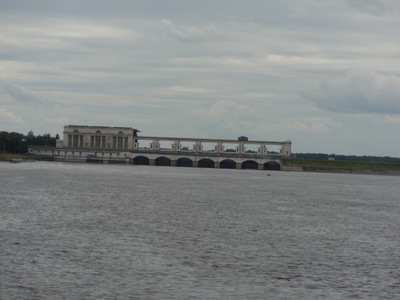
 During lunch we approached but did not pass through another lock. The left-hand photo shows the dam as we approached it; the lock to the left of the dam, not visible in this shot.
During lunch we approached but did not pass through another lock. The left-hand photo shows the dam as we approached it; the lock to the left of the dam, not visible in this shot.
For dessert, we all passed up the apricot roulade with fresh strawberries and whipped cream for the black forest ice cream coupe (chocolate-cherry ice cream, marinated warm cherries, and whipped cream).

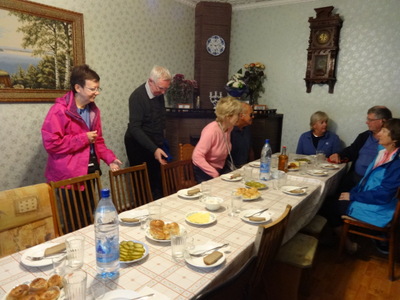 AT the left is a small country church we passed as we approached Uglich. Note the green domes. The domes were clad in overlapping, leaf-shaped wooden shingles, curved to fit the surface and painted green.
AT the left is a small country church we passed as we approached Uglich. Note the green domes. The domes were clad in overlapping, leaf-shaped wooden shingles, curved to fit the surface and painted green.
When we reached Uglich, we were moored as near as physically possible to the center of town, so the walking tour started right from the ship. The day's activities were divided between that tour and our "home-hosted visit." We were assigned to the half doing the visit first and the tour after, so we were further subdivided into groups of 12 to 14 (Viking is very careful to keep track of sets of "travelling companions" and always to assign us and the Sinnetts to the same group) and boarded small city buses to be ferried to the home that would host us.
The right-hand photo show us gathering around a long table set for us in the host's dining room. As you can see, each of us got a water glass and a small plate with a fork and half a slice of brown bread. The table was set with a slices of a well-known locally made cheese, home-made pickles, and home-made pastries. Rachel and I didn't think the cheese was anything to write home about, but the pickles and pastries were excellent.
In country towns like Uglich, home-made vodka is very common, and our hosts served us small glasses of their own vintage. It's apparently made only of sugar, yeast, and water (they don't even bother with potatoes) and then steeped with usually secret and proprietary assortments of herbs for favoring. Our hosts' was the color of cognac (you can see a bottle of it on the table, along with big bottles of water) and was declared excellent by those who drank it.
After that, we were served cups of tea (way better than the Twinings stuff we were getting on the ship) and made heavy inroads on the food.
Our hosts, whose names I have alas forgotten, were an older married couple with grown children. He is night supervisor of a quail farm, and I think she was a teacher. Around the table, they told us about their lives—tour escort Sasha translated—and we had the chance to ask questions. Our host had very good answers (and very diplomatic ones, when the quesions were about Trump), and I think they were sincere, although he couldn't help sounding a little practiced—they do this Viking thing at least a couple of times a week, so they must get the same questions over and over. I hope Viking pays them handsomely. The host understood a good deal of English (the hostess less so) but answered in Russian.

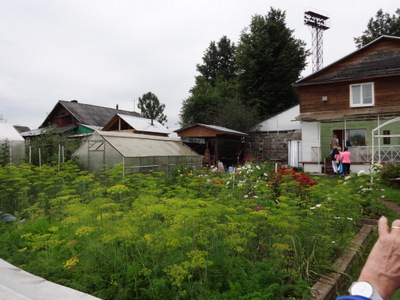 Like all Russians given the slightest opportunity they have a huge garden, which we got to explore after the tea and discussion. Their proper is long from front to back—you enter through a narrow end of the house, which they extends away from the road, and the garden extends a long way out the back of that. You can see the chicken coop at the far end, begin examined by Sasha and three others of our party.
Like all Russians given the slightest opportunity they have a huge garden, which we got to explore after the tea and discussion. Their proper is long from front to back—you enter through a narrow end of the house, which they extends away from the road, and the garden extends a long way out the back of that. You can see the chicken coop at the far end, begin examined by Sasha and three others of our party.
They grew lots of flowers of many kinds as well as apples, pears, red and black currants (and even white ones), gooseberries, raspberries, cabbages, onions, leeks, peas, potatoes, rhubarb, carrots, beets, grapes, tomatoes, strawberries, and herbs (mint, basil, sorrel, and vast amounts of dill, as you can see from the right-hand photo). The half-cylinder plastic greenhouse is entirely devoted to cucumbers. I think the rectilinear one was mostly tomatoes.
They also keep chickens of an assortment of sizes and breeds and ducks (the same). And a couple of beehives.

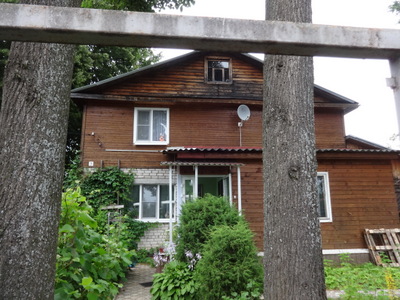 On the back porch was this basket of duck eggs. I also saw hen's eggs and quail eggs on the same shelf, and the brown object in the plastic clamshell to the left of the eggs is a slab of honeycomb.
On the back porch was this basket of duck eggs. I also saw hen's eggs and quail eggs on the same shelf, and the brown object in the plastic clamshell to the left of the eggs is a slab of honeycomb.
The photo at the right is the door we entered the house by. Note the satellite dish over the door. They had only a smallish TV (just out of the frame to the right in the photo of the dining table), but someone asked about TV service, and the answer was that they get 400 channels.
Russians are obsessed with vegetable gardening and especially with pickling, and these folks were no exception. We were told they had hundreds of jars of canned and pickled produce in the basement.

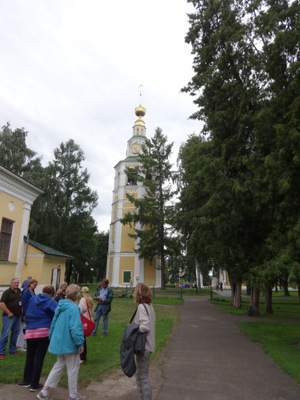 Uglich is a very old town, founded 936 AD (though it and its kremlin were burned to the ground by the Mongols, so nothing dates from the 10th century. It currently has four claims to fame (and three major employers): the cheese factory whose product we sampled during our home visit, the hydroelectric plant on the dam (we didn't get a chance to visit the hydroelectric museum), a watch factory, and last, the site where little Dmitri Tsarevitch was probably murdered by Boris Gudonov (in 1591), ending the Rurik dynasty.
Uglich is a very old town, founded 936 AD (though it and its kremlin were burned to the ground by the Mongols, so nothing dates from the 10th century. It currently has four claims to fame (and three major employers): the cheese factory whose product we sampled during our home visit, the hydroelectric plant on the dam (we didn't get a chance to visit the hydroelectric museum), a watch factory, and last, the site where little Dmitri Tsarevitch was probably murdered by Boris Gudonov (in 1591), ending the Rurik dynasty.
It's about 250 km from Moscow, and it has 15 churches and 4 monastaries active now. The guides repeatedly referred to it as a "small country town," but the population is almost 35,000.
The walking tour was of the Uglich Kremlin. If you Google-map it, it just looks like a section of the river bank between the river and the town, but if you look at the aerial view, you'll see that it is (or was) a small triangular island surrounded by the river on one side and a moat on the other two. Some of the moat has silted up now, though it still looks too marshy to walk on (or march an army over). The island is more like a park studded with churches than like, e.g., the Moscow Kremlin. The trees are mostly larches, pines, and birches. (Because the ship's library had no tree book, I never got a good identification of the pine with reddish bark that I saw everywhere.
The yellow and white building in the left-hand photo is Cathedral of the Epiphany, and the photo at the right is of its nearby bell tower. I don't think it's currently an active church (we toured so many in quick succession that it's hard to keep track). In any case, we were treated to a brief concert there by a six-man vocal group (accompanied by a large balalika) called Kovcheg; if you Google "kovcheg ensemble" you can see photos and even hear them sing (some of the videos show only five guys). They were really good (amazing bass!). Their CDs were for sale, but we didn't buy any (you can probably get them on line). This was the first of several small vocal ensembles to present concerts at venues we toured; all were selling CDs. Among them, they covered all the classic folk songs we hoped to hear but never repeated, so Viking must coordinate the repertoirs and warn them in advance of what others will be singing.

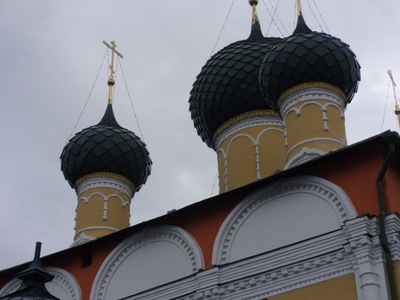 Here's another cathedral, St. Dmitri, together with a closer view of some of its domes, showing the overlapping, leaf-shaped shingles.
Here's another cathedral, St. Dmitri, together with a closer view of some of its domes, showing the overlapping, leaf-shaped shingles.
The guide explained that the domes around here are green or blue because blue is the color of heaven and green that of life.
I hope I've got the right names associated with the right photos. The Kremlin is supposed to include three cathedrals: epiphany, transfiguration, and St. Dmitri, but I only have photos of two. (Note that all the photos on this page aren't mine. Ev got better shots than I did, so I used several of his.)
According to my notes, the Cathedral of the Transfiguration is yellow with green domes.
Anyway, St. Dmitri has wooden frames over its windows in the shape of the kokoshnik, the headdress traditionally worn by young, unmarried women. It's symbolic of purity, since the prince died so young and innocent. Its refectory was painted by locals. In the 18th century, it was paved with tesselated cast iron slabs (ovals with peaks top and bottom, sort of like broad, flat turnips, so that it would be heated from below. The fresco in the nave was painted by Moscow artists, not locals. I have no photos because I didn't pay the 100 rubles for the privilege of using my camera. Michael, the first Romanov tsar, donated an icon of the virgin because his mother had an estate in Uglich.


These two photos show the house where young Dmitri and his entourage lived (he's sometimes called Dmitri of Uglich), viewed from different sides.
He apparently died near the foot of the exterior staircase.
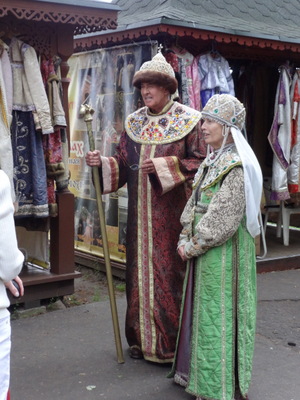
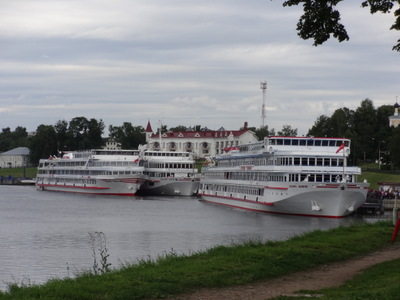 After the tours, we had a little time to shop in the few souvensir stands right there in the Kremlin. The left-hand photo shows two members of our group dressed in costumes provided by the photographer, to have their photos made as members of the Russian aristocracy, presumably in Dmitri's time.
After the tours, we had a little time to shop in the few souvensir stands right there in the Kremlin. The left-hand photo shows two members of our group dressed in costumes provided by the photographer, to have their photos made as members of the Russian aristocracy, presumably in Dmitri's time.
The right-hand photo is the view of our ship from the area of the souvenir shops. The Akun is in the middle, with the Tolstoy moored outboard of her. The ship nearest the camera is labeled "Zosima Shashkov," a name that means nothing to me. I had to transliterate it myself, as it appeared in Cyrillic on both the bow and the side, so it was presumably a Russian-speaking ship.
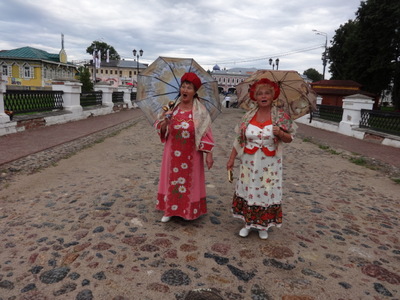
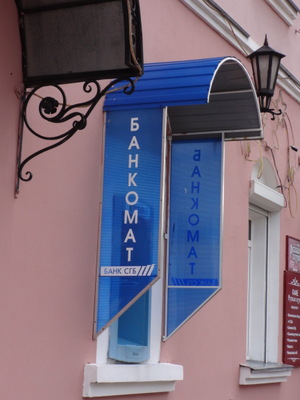 As we first came ashore (before the home visit and the tour), we were greeted by an ensemble of two sets of drums, a sax, and an accordion. They were initially playing Kalinka, but as soon as they heard us speaking English, they switched to what they considered more a more appropriate welcome: The Battle Hymn of the Republic and When the Saints Go Marching In. This routine happened several times in the course of the trip.
As we first came ashore (before the home visit and the tour), we were greeted by an ensemble of two sets of drums, a sax, and an accordion. They were initially playing Kalinka, but as soon as they heard us speaking English, they switched to what they considered more a more appropriate welcome: The Battle Hymn of the Republic and When the Saints Go Marching In. This routine happened several times in the course of the trip.
On the bridge leading from the mooring place into the town, though, we encountered this pair of older ladies busking, and they were singing approriate Russian stuff. They got the tip that the others didn't.
At the right is a photo of the "Bankomat" (i.e., ATM) that David and Ev found in the shopping area of the town. Unfortunately, it didn't speak English, and they couldn't manage to navigate its workings. Rachel and I were looking at the items in the gift shops (the usual stuff, but also lots and lots of locally made clocks and watches), and we had run into Program Directory Margo, who was making the rounds of the shops in case anyone needed help. When the guys came to find us, she went off with them to help make the machine cough up the dough.
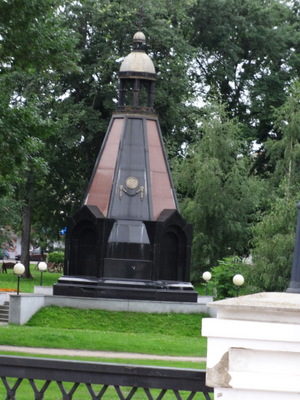

Where the bridge from the Kremlin met the town square, a vast area of it had been paved for use as a parking lot, but it had also been laid out with a painted on track for children to drive on in their electic or pedal cars, and that's the use it was begin put to when we were there.
The photo at the left is of the town's war memorial, and that on the right is the town's first public library, opened 27 July 1897 (according to the plaque), in honor of the coronation of Tsar Nicholas II. It started with 5477 books and 38 periodicals. It charged a fee, but the fee was waived for teachers, clerks, and students who came to Uglich on vacation.
Around the square were arrayed the more serious souvenire and watch shops
Finally, we walked back to the ship, where the crew once again hastily counted noses and set sail while we had dinner.
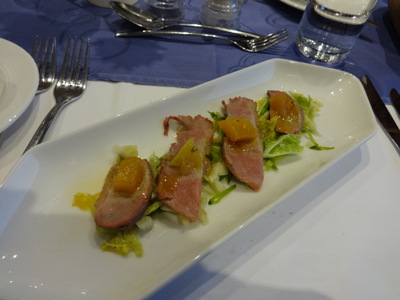
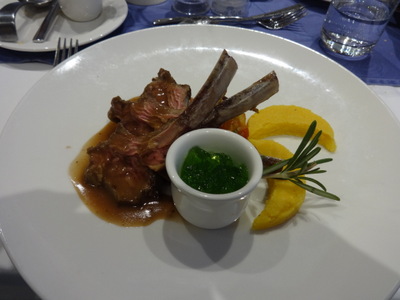 I started with "cured roasted duck breast and Thai mango salad," which took the form of these slices of duck on a bed of lightly cooked cabbage, each topped with chungs of marinated mango. Very good.
I started with "cured roasted duck breast and Thai mango salad," which took the form of these slices of duck on a bed of lightly cooked cabbage, each topped with chungs of marinated mango. Very good.
I think Rachel started with the arugula and watermelon salad, and I don't think anyone had the "Viking goat cheese souflée" or the russian "rassolnik" soup.
Ev had his usual cheese plate, of course, which this evening was Gouda and a Bavarian Grand bleu.

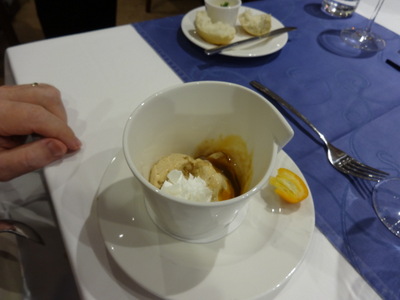 The main-course choices were roasted rack of lamb with ratatouille, gnocchi al romain, rosemary sauce, and mint jelly; honey BBQ filet of salmon with polenta spring roll and asparagus; and baked zucchini stuffed with feta cheese with aartichoke-tomato ragout. I think we all opted for the lamb.
The main-course choices were roasted rack of lamb with ratatouille, gnocchi al romain, rosemary sauce, and mint jelly; honey BBQ filet of salmon with polenta spring roll and asparagus; and baked zucchini stuffed with feta cheese with aartichoke-tomato ragout. I think we all opted for the lamb.
The two main dessert choices were tiramisu and pineapple cake. Three of us had the tiramisu, but David (fearing the caffeine) just had ice cream, which was "crème catalana" (i.e., Spanish-style crème brulée) flavored and came with caramel sauce and half a kumquat.
The tiramisu was made in little square dishes that tapered sharply downward to a narrow bottom. As a result, the layer of cake and (very little) coffee was dwarfed by the thick layer of mascarpone filling piped on top—good, but a little cloying. The dish on the side holds strawberry sauce.
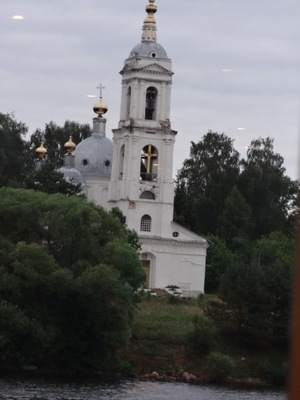 Here's a picturesque structure we cruised past during dinner.
Here's a picturesque structure we cruised past during dinner.
Lest anyone be bored in the interval between dinner and the evening's musical entertainment featuring Sigmund and Elena, Margo organized a quiz game in the Sky Bar called "And the top answer is . . ." David went to bed, but Ev, Rachel, and I gave it a try.
The format was that Margo would pose a question and offer four multiple-choice answers. We were to choose the "most popular" answer. Consumate scientist that he is, Ev first asked how the choices were arrived at and how the "correct" answer was chosen. The answer to that was that the question was first posed to a large sample of Viking employees, and answers were tallied. The top four answers for each of the questions were then presented in the multiple-choice format to a sample of 100 Viking guests, and their most popular choice was deemed the "correct" answer.
The questions included things like "Name a musical instrument that's inconvenient to fly with." ("Tuba" for 24 points.) The points awarded for each question totaled 100 and were divided among the possible answers in proportion to the number of people in the sample of 100 who chose it. Another was "Name a body part that gives you trouble as you age." ("Knees" for only 18 points.) "What's something that a man should not bring on his honeymoon." (The choices included "another woman" and "golf clubs"; we got 28 points for "his mother"). We got only 9 points for naming "balloon" as "something you fill with air" ("tire" was the top answer) and zero for naming "book" as "something you take on holiday" (the top answer was "passport," which all the Brits and Australians got, but which tends not to occur to Americans). Needless to say, we didn't do terrifically well—272 points out of 1000. The winners had 305.
Previous entry
List of Entries
Next entry

 Here's my breakfast plate (while I wait for my eggs over easy from the omelet station) in the lovely low-angle light of the morning. The little green things in the sausage, which I took to be pistachios, turned out to be hot peppers. Nowhere near as good as the ones with cheese in them. The little bread buns, though, split and buttered and filled with raw ham make excellent French-style sandwiches.
Here's my breakfast plate (while I wait for my eggs over easy from the omelet station) in the lovely low-angle light of the morning. The little green things in the sausage, which I took to be pistachios, turned out to be hot peppers. Nowhere near as good as the ones with cheese in them. The little bread buns, though, split and buttered and filled with raw ham make excellent French-style sandwiches.
 Lunch started with the usual buffet. The featured items were Ukrainian tomatoes —tomato halves with machicolated edges stuffed with cheese, garlic, and sour cream—which I didn't try, and pork loin with braised cabbage.
Lunch started with the usual buffet. The featured items were Ukrainian tomatoes —tomato halves with machicolated edges stuffed with cheese, garlic, and sour cream—which I didn't try, and pork loin with braised cabbage.
 During lunch we approached but did not pass through another lock. The left-hand photo shows the dam as we approached it; the lock to the left of the dam, not visible in this shot.
During lunch we approached but did not pass through another lock. The left-hand photo shows the dam as we approached it; the lock to the left of the dam, not visible in this shot.
 AT the left is a small country church we passed as we approached Uglich. Note the green domes. The domes were clad in overlapping, leaf-shaped wooden shingles, curved to fit the surface and painted green.
AT the left is a small country church we passed as we approached Uglich. Note the green domes. The domes were clad in overlapping, leaf-shaped wooden shingles, curved to fit the surface and painted green.
 Like all Russians given the slightest opportunity they have a huge garden, which we got to explore after the tea and discussion. Their proper is long from front to back—you enter through a narrow end of the house, which they extends away from the road, and the garden extends a long way out the back of that. You can see the chicken coop at the far end, begin examined by Sasha and three others of our party.
Like all Russians given the slightest opportunity they have a huge garden, which we got to explore after the tea and discussion. Their proper is long from front to back—you enter through a narrow end of the house, which they extends away from the road, and the garden extends a long way out the back of that. You can see the chicken coop at the far end, begin examined by Sasha and three others of our party.
 On the back porch was this basket of duck eggs. I also saw hen's eggs and quail eggs on the same shelf, and the brown object in the plastic clamshell to the left of the eggs is a slab of honeycomb.
On the back porch was this basket of duck eggs. I also saw hen's eggs and quail eggs on the same shelf, and the brown object in the plastic clamshell to the left of the eggs is a slab of honeycomb.
 Uglich is a very old town, founded 936 AD (though it and its kremlin were burned to the ground by the Mongols, so nothing dates from the 10th century. It currently has four claims to fame (and three major employers): the cheese factory whose product we sampled during our home visit, the hydroelectric plant on the dam (we didn't get a chance to visit the hydroelectric museum), a watch factory, and last, the site where little Dmitri Tsarevitch was probably murdered by Boris Gudonov (in 1591), ending the Rurik dynasty.
Uglich is a very old town, founded 936 AD (though it and its kremlin were burned to the ground by the Mongols, so nothing dates from the 10th century. It currently has four claims to fame (and three major employers): the cheese factory whose product we sampled during our home visit, the hydroelectric plant on the dam (we didn't get a chance to visit the hydroelectric museum), a watch factory, and last, the site where little Dmitri Tsarevitch was probably murdered by Boris Gudonov (in 1591), ending the Rurik dynasty.
 Here's another cathedral, St. Dmitri, together with a closer view of some of its domes, showing the overlapping, leaf-shaped shingles.
Here's another cathedral, St. Dmitri, together with a closer view of some of its domes, showing the overlapping, leaf-shaped shingles.



 After the tours, we had a little time to shop in the few souvensir stands right there in the Kremlin. The left-hand photo shows two members of our group dressed in costumes provided by the photographer, to have their photos made as members of the Russian aristocracy, presumably in Dmitri's time.
After the tours, we had a little time to shop in the few souvensir stands right there in the Kremlin. The left-hand photo shows two members of our group dressed in costumes provided by the photographer, to have their photos made as members of the Russian aristocracy, presumably in Dmitri's time.
 As we first came ashore (before the home visit and the tour), we were greeted by an ensemble of two sets of drums, a sax, and an accordion. They were initially playing Kalinka, but as soon as they heard us speaking English, they switched to what they considered more a more appropriate welcome: The Battle Hymn of the Republic and When the Saints Go Marching In. This routine happened several times in the course of the trip.
As we first came ashore (before the home visit and the tour), we were greeted by an ensemble of two sets of drums, a sax, and an accordion. They were initially playing Kalinka, but as soon as they heard us speaking English, they switched to what they considered more a more appropriate welcome: The Battle Hymn of the Republic and When the Saints Go Marching In. This routine happened several times in the course of the trip.



 I started with "cured roasted duck breast and Thai mango salad," which took the form of these slices of duck on a bed of lightly cooked cabbage, each topped with chungs of marinated mango. Very good.
I started with "cured roasted duck breast and Thai mango salad," which took the form of these slices of duck on a bed of lightly cooked cabbage, each topped with chungs of marinated mango. Very good.
 The main-course choices were roasted rack of lamb with ratatouille, gnocchi al romain, rosemary sauce, and mint jelly; honey BBQ filet of salmon with polenta spring roll and asparagus; and baked zucchini stuffed with feta cheese with aartichoke-tomato ragout. I think we all opted for the lamb.
The main-course choices were roasted rack of lamb with ratatouille, gnocchi al romain, rosemary sauce, and mint jelly; honey BBQ filet of salmon with polenta spring roll and asparagus; and baked zucchini stuffed with feta cheese with aartichoke-tomato ragout. I think we all opted for the lamb. Here's a picturesque structure we cruised past during dinner.
Here's a picturesque structure we cruised past during dinner.